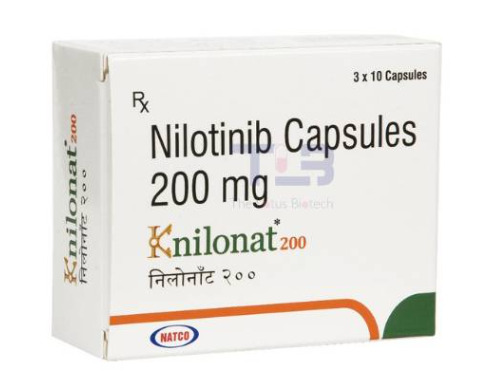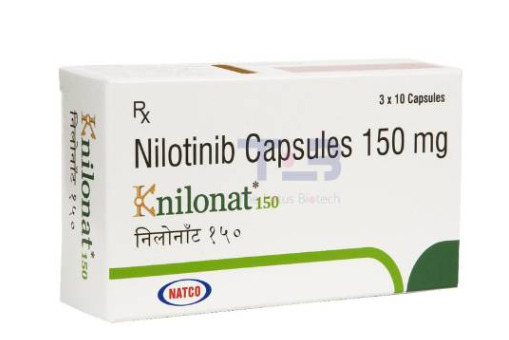#Nilotinib
Text

Knilonat is a chemotherapeutic drug used to treat chronic myeloid leukemia (CML). It contains the active salt nilotinib which successfully treats blood cancer by blocking certain proteins linked to uncontrolled white blood cell growth.
Enquire Now: https://snip.ly/383ub9
#Nilotinib#Nilotinib 200 MG#Oncology#Oncology Medicine#Nilotinib Capsules#Knilonat 200 MG#Knilonat 200mg Nilotinib Capsules#pharmaceutical exporter#pharmaceutical wholesaler#pharmaceutical supplier#pharmaceutical distributor#thelotusbiotech#tlb
0 notes
Text

Knilonat 150mg is a chemotherapeutic drug used to treat chronic myeloid leukemia (CML). It contains the active salt nilotinib which successfully treats blood cancer by blocking certain proteins linked to uncontrolled white blood cell growth.
Enquire Now: https://snip.ly/vqnv6l
#Nilotinib#Nilotinib (150mg)#Nilotinib Capsules#Knilonat 150mg#Knilonat 150mg Capsules#Nilotinib 150 Mg Capsules#Pharmaceutical Exporter#Pharmaceutical Importer#Pharmaceutical Wholesaler
0 notes
Text
0 notes
Text
Advances in Leukemia Therapeutics: Innovations and Emerging Trends
The Evolving Landscape of Leukemia Treatment

Leukemia, a group of malignancies that affect the blood and bone marrow, continues to challenge the medical community with its complexity and variability. Recent years have seen significant strides in leukemia therapeutics, driven by advancements in drug development, personalized medicine, and novel therapeutic strategies. These innovations are transforming treatment paradigms, offering new hope to patients and paving the way for more effective and targeted therapies.
Breakthroughs in Drug Development
One of the most significant advancements in leukemia therapeutics is the development of targeted therapies. Unlike traditional chemotherapy, which indiscriminately kills rapidly dividing cells, targeted therapies are designed to attack specific molecules involved in cancer progression. For instance, tyrosine kinase inhibitors (TKIs) like imatinib, dasatinib, and nilotinib have revolutionized the treatment of chronic myeloid leukemia (CML). These drugs target the BCR-ABL protein, a key driver of CML, leading to improved outcomes and reduced side effects compared to conventional treatments.
In addition to TKIs, the approval of novel agents such as venetoclax has marked a significant leap forward. Venetoclax targets the BCL-2 protein, which is often overexpressed in leukemia cells, thereby promoting their survival. By inhibiting BCL-2, venetoclax enhances the effectiveness of chemotherapy and has shown promise in treating acute myeloid leukemia (AML) and chronic lymphocytic leukemia (CLL).
Advances in Immunotherapy
Immunotherapy is another area where substantial progress has been made. Chimeric antigen receptor (CAR) T-cell therapy represents a groundbreaking approach, especially for acute lymphoblastic leukemia (ALL) and some cases of CLL. This therapy involves modifying a patient's T-cells to express a CAR that targets leukemia-specific antigens. The modified T-cells are then reintroduced into the patient’s body, where they identify and destroy leukemia cells.
Recent studies have demonstrated the efficacy of CAR T-cell therapies, leading to impressive remission rates in patients with refractory or relapsed leukemia. However, this approach is not without challenges. The risk of cytokine release syndrome (CRS) and neurotoxicity remains a concern, and ongoing research aims to enhance the safety and effectiveness of CAR T-cell therapies.
The Leukemia Therapeutics Market size was USD 16 Billion in 2023 and is expected to Reach USD 27.28 Billion by 2031 and grow at a CAGR of 6.9% over the forecast period of 2024-2031.
Precision Medicine and Genetic Insights
The era of precision medicine has ushered in a new approach to leukemia treatment, with a focus on tailoring therapies based on individual genetic profiles. Advances in genomic sequencing have identified specific mutations and genetic alterations associated with different types of leukemia. For example, mutations in the FLT3 gene are common in AML, and targeted inhibitors like midostaurin are being used to address these mutations.
Similarly, research into the genetic underpinnings of CLL has led to the development of drugs that target specific mutations or pathways involved in the disease. By understanding the unique genetic landscape of each patient’s leukemia, clinicians can select the most effective therapies and potentially improve treatment outcomes.
Future Directions and Challenges
While the progress in leukemia therapeutics is promising, several challenges remain. The high cost of novel therapies, including CAR T-cell treatments, poses a significant barrier to access for many patients. Additionally, the development of resistance to targeted therapies and immunotherapies requires ongoing research to develop new and effective treatment options.
Looking ahead, researchers are exploring combination therapies, novel drug targets, and personalized approaches to overcome these challenges. The integration of artificial intelligence and machine learning in drug discovery and treatment planning holds the potential to further accelerate progress in leukemia therapeutics.
Conclusion
The field of leukemia therapeutics is undergoing a transformative phase, with innovations in drug development, immunotherapy, and precision medicine leading the way. These advancements are not only enhancing treatment outcomes but also offering new hope to patients. As research continues to evolve, the focus will remain on overcoming current challenges and pushing the boundaries of what is possible in the fight against leukemia.
0 notes
Text
Quality Control and Regulatory Compliance in Nilotinib API Manufacturing

In the pharmaceutical industry, ensuring the highest standards of quality control and regulatory compliance is critical, particularly when manufacturing Active Pharmaceutical Ingredients (APIs) like Nilotinib. Nilotinib is used in the treatment of chronic myeloid leukemia, and any compromise in its quality can have serious implications for patient health. Therefore, manufacturers must adhere to stringent quality control processes and meet rigorous regulatory standards to ensure the safety and efficacy of their products.
The Importance of Quality Control
Quality control (QC) in the manufacturing of Nilotinib API is paramount. This process involves rigorous testing and monitoring to ensure that the API meets all specified criteria for identity, purity, potency, and safety. Effective quality control processes help to detect and eliminate any defects or inconsistencies that may arise during production.
A robust QC system includes a variety of testing methodologies, such as:
Raw Material Testing: Ensuring that all raw materials used in the production of Nilotinib meet predefined quality standards before they enter the manufacturing process.
In-Process Testing: Continuous monitoring of the manufacturing process to ensure that each step meets quality requirements. This can include checks for pH levels, temperature controls, and intermediate product specifications.
Finished Product Testing: Comprehensive testing of the final API product to confirm its compliance with predefined quality attributes, including assay, impurity levels, and dissolution properties.
Regulatory Compliance Standards
Pharmaceutical manufacturers must comply with various regulatory standards set by health authorities such as the U.S. Food and Drug Administration (FDA), European Medicines Agency (EMA), and other international regulatory bodies. These regulations are designed to ensure that APIs, including Nilotinib, are produced consistently and are safe for use.
Key regulatory requirements include:
Current Good Manufacturing Practices (cGMP): These are guidelines provided by regulatory agencies that outline the standards for manufacturing, testing, and quality assurance. Adhering to cGMP ensures that products are consistently produced and controlled to the quality standards appropriate for their intended use.
ICH Guidelines: The International Council for Harmonisation of Technical Requirements for Pharmaceuticals for Human Use (ICH) provides guidelines that harmonize the regulation of pharmaceuticals across Europe, Japan, and the United States. These guidelines cover aspects such as quality, safety, efficacy, and multidisciplinary topics.
Regulatory Inspections: Regular inspections by regulatory authorities ensure compliance with cGMP and other regulations. These inspections can include reviews of manufacturing processes, quality control systems, and documentation practices.
Best Practices for Ensuring High-Quality and Compliant API Manufacturing
To maintain high standards of quality control and regulatory compliance, Nilotinib API manufacturers can adopt several best practices:
Implementing a Comprehensive Quality Management System (QMS): A QMS integrates all quality-related processes and procedures, ensuring that quality control and compliance are maintained throughout the manufacturing lifecycle. This includes document control, training, corrective and preventive actions (CAPA), and regular internal audits.
Training and Development: Continuous training and development programs for employees ensure that they are knowledgeable about the latest quality control techniques and regulatory requirements. This helps in maintaining a culture of quality and compliance within the organization.
Supplier Quality Management: Establishing robust relationships with suppliers and conducting regular audits ensures that raw materials meet the necessary quality standards. This reduces the risk of contamination or variability in the final product.
Utilizing Advanced Analytical Techniques: Employing state-of-the-art analytical techniques, such as high-performance liquid chromatography (HPLC) and mass spectrometry, enhances the accuracy and reliability of quality testing. These techniques help in the precise identification and quantification of impurities and active components.
Continuous Improvement: Implementing a culture of continuous improvement, where feedback from quality control processes and regulatory inspections is used to enhance manufacturing practices. This can involve process optimization, technological upgrades, and adopting industry best practices.
Conclusion
Quality control and regulatory compliance are critical components of Nilotinib API manufacturing. By implementing robust quality management systems, adhering to regulatory guidelines, and adopting best practices, manufacturers can ensure that their products meet the highest standards of safety and efficacy. This not only protects patient health but also enhances the manufacturer's reputation and trustworthiness in the pharmaceutical industry.
0 notes
Text

𝐀𝐛𝐬𝐭𝐫𝐚𝐜𝐭: Nilotinib is a highly selective second-generation Bcr-Abl tyrosine kinaseInhibitor (#tki s), which is effective in #patients with #philadelphia chromosome–positive #ChronicMyeloidLeukemia (#CML). #tyrosine kinase inhibitors have broadly similar types of non-hematological adverse #sideeffects (AES), but some of the AES are specific to one drug compared to the others.
View more here @ https://symbiosisonlinepublishing.com/hematology/hematology20.php
#symbiosisonlinepublishing #hematology #hematologia #hematologist #skinrash #leukemia #chronicillness #chronicillnessawareness #journalwithme #journals #journal #pubmed #peerreviewed #peerreview #OpenAccess
0 notes